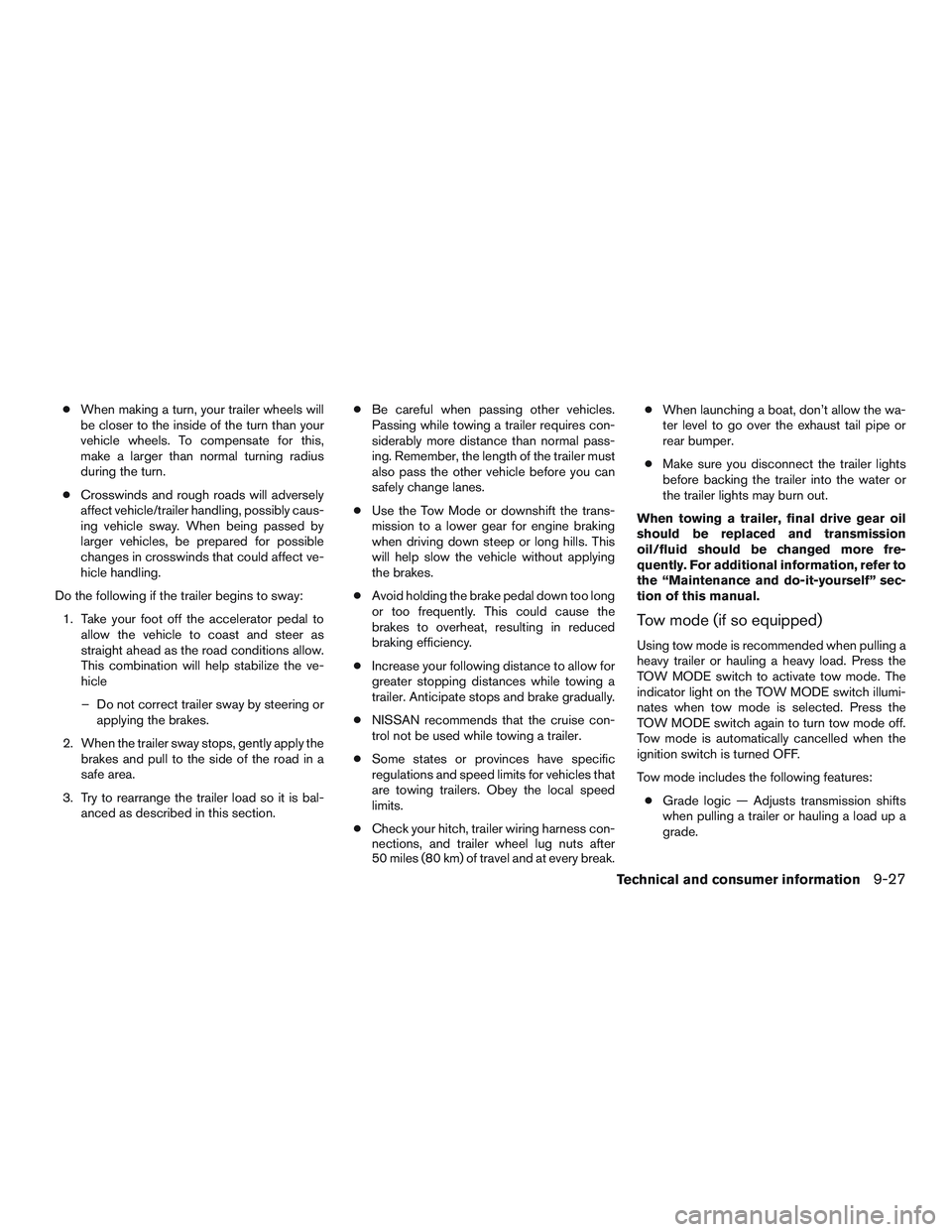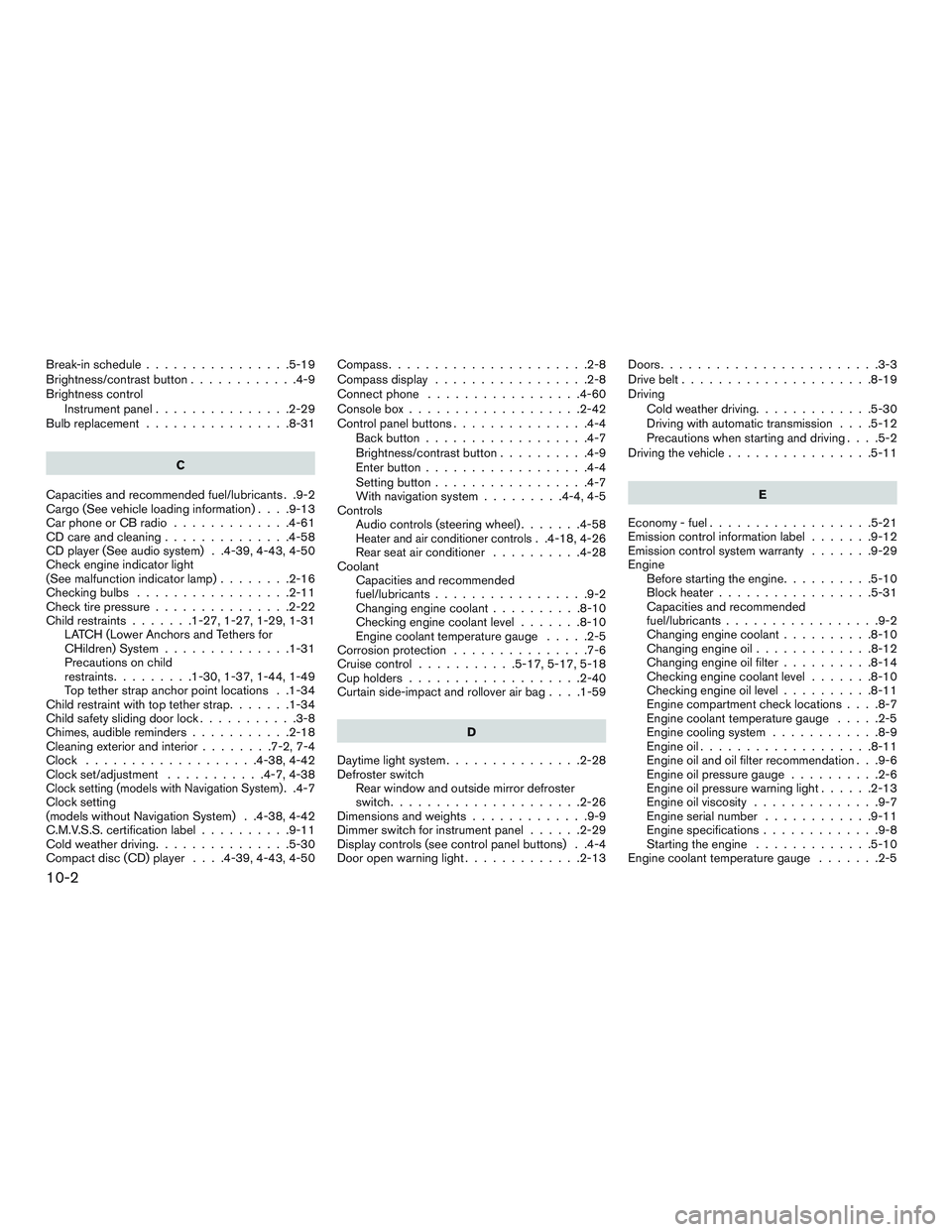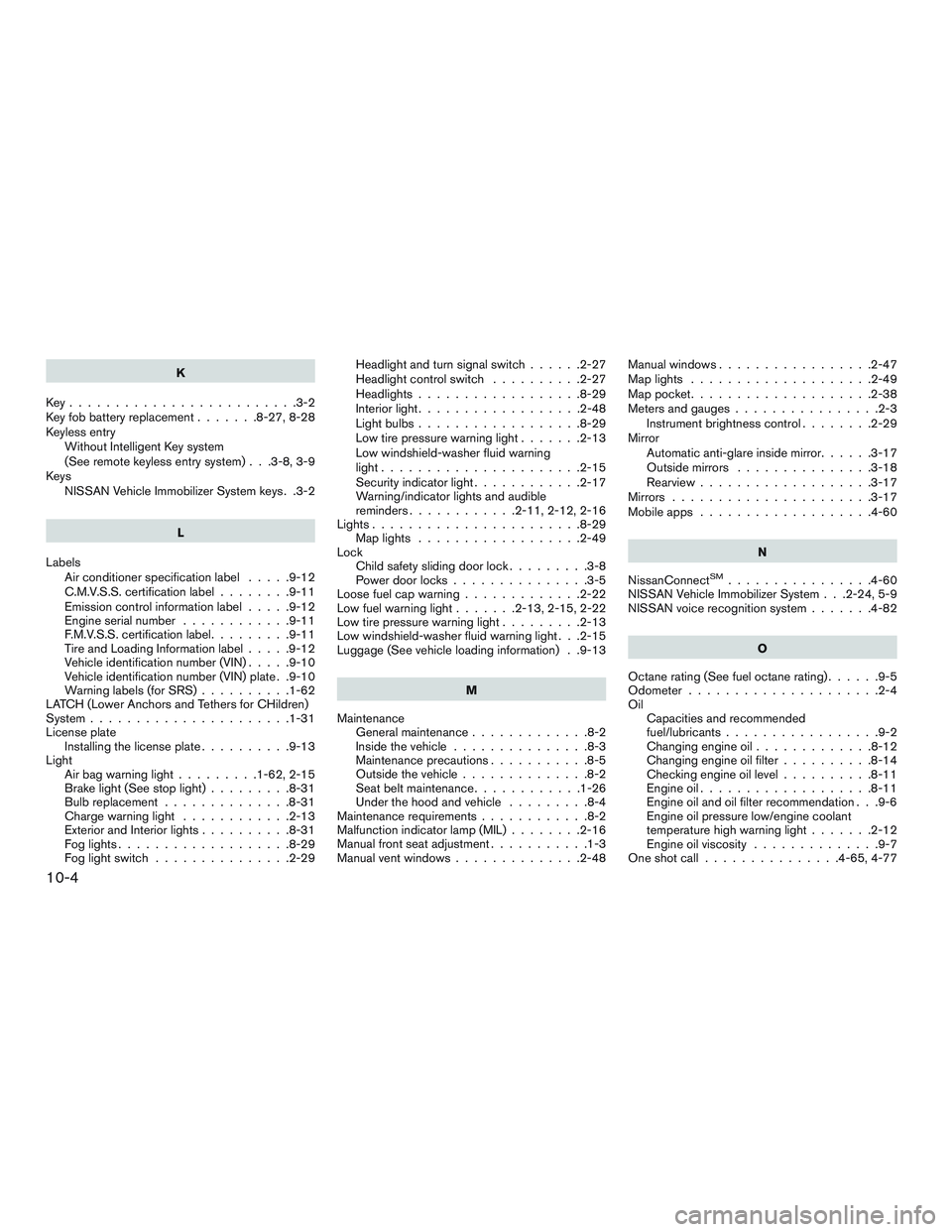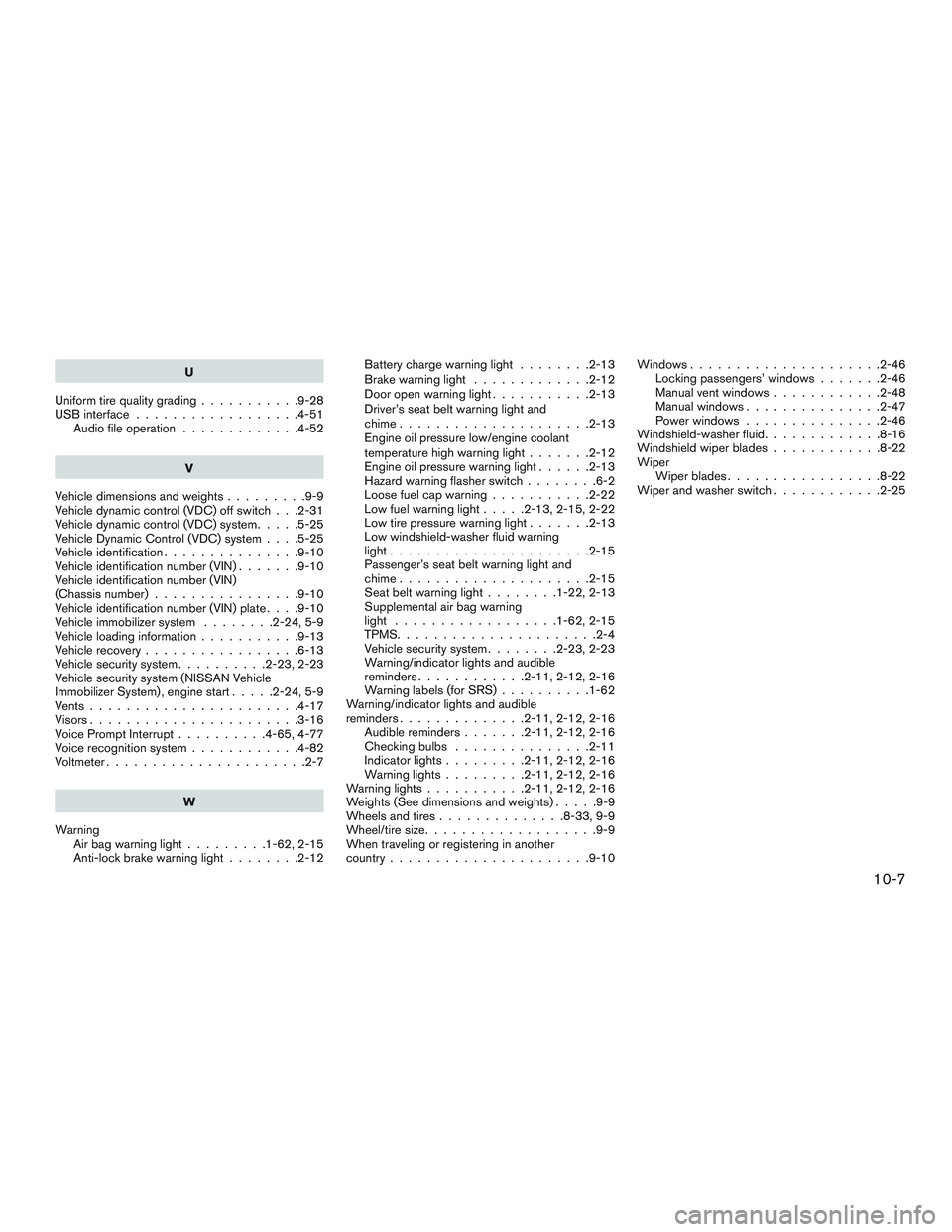2016 NISSAN NV PASSENGER VAN check engine light
[x] Cancel search: check engine lightPage 366 of 380

●When making a turn, your trailer wheels will
be closer to the inside of the turn than your
vehicle wheels. To compensate for this,
make a larger than normal turning radius
during the turn.
● Crosswinds and rough roads will adversely
affect vehicle/trailer handling, possibly caus-
ing vehicle sway. When being passed by
larger vehicles, be prepared for possible
changes in crosswinds that could affect ve-
hicle handling.
Do the following if the trailer begins to sway: 1. Take your foot off the accelerator pedal to allow the vehicle to coast and steer as
straight ahead as the road conditions allow.
This combination will help stabilize the ve-
hicle
– Do not correct trailer sway by steering or applying the brakes.
2. When the trailer sway stops, gently apply the brakes and pull to the side of the road in a
safe area.
3. Try to rearrange the trailer load so it is bal- anced as described in this section. ●
Be careful when passing other vehicles.
Passing while towing a trailer requires con-
siderably more distance than normal pass-
ing. Remember, the length of the trailer must
also pass the other vehicle before you can
safely change lanes.
● Use the Tow Mode or downshift the trans-
mission to a lower gear for engine braking
when driving down steep or long hills. This
will help slow the vehicle without applying
the brakes.
● Avoid holding the brake pedal down too long
or too frequently. This could cause the
brakes to overheat, resulting in reduced
braking efficiency.
● Increase your following distance to allow for
greater stopping distances while towing a
trailer. Anticipate stops and brake gradually.
● NISSAN recommends that the cruise con-
trol not be used while towing a trailer.
● Some states or provinces have specific
regulations and speed limits for vehicles that
are towing trailers. Obey the local speed
limits.
● Check your hitch, trailer wiring harness con-
nections, and trailer wheel lug nuts after
50 miles (80 km) of travel and at every break. ●
When launching a boat, don’t allow the wa-
ter level to go over the exhaust tail pipe or
rear bumper.
● Make sure you disconnect the trailer lights
before backing the trailer into the water or
the trailer lights may burn out.
When towing a trailer, final drive gear oil
should be replaced and transmission
oil/fluid should be changed more fre-
quently. For additional information, refer to
the “Maintenance and do-it-yourself” sec-
tion of this manual.
Tow mode (if so equipped)
Using tow mode is recommended when pulling a
heavy trailer or hauling a heavy load. Press the
TOW MODE switch to activate tow mode. The
indicator light on the TOW MODE switch illumi-
nates when tow mode is selected. Press the
TOW MODE switch again to turn tow mode off.
Tow mode is automatically cancelled when the
ignition switch is turned OFF.
Tow mode includes the following features: ● Grade logic — Adjusts transmission shifts
when pulling a trailer or hauling a load up a
grade.
Technical and consumer information9-27
Page 370 of 380

Due to legal requirements in some states and
Canadian Provinces, your vehicle may be re-
quired to be in what is called the “ready condi-
tion” for an Inspection/Maintenance (I/M) test of
the emission control system.
The vehicle is set to the “ready condition” when it
is driven through certain driving patterns. Usually,
the ready condition can be obtained by ordinary
usage of the vehicle.
If a powertrain system component is repaired or
the battery is disconnected, the vehicle may be
reset to a “not ready” condition. Before taking the
I/M test, check the vehicle’s
inspection/maintenance test readiness condi-
tion. Place the ignition switch in the ON position
without starting the engine. If the Malfunction
Indicator Light (MIL) comes on steady for 20 sec-
onds and then blinks for 10 seconds , the I/M test
condition is “not ready”. If the MIL does not blink
after 20 seconds, the I/M test condition is
“ready”. Contact a NISSAN dealer to set the
“ready condition” or to prepare the vehicle for
testing.This vehicle is equipped with an Event Data Re-
corder (EDR) . The main purpose of an EDR is to
record, in certain crash or near crash-like situa-
tions, such as an air bag deployment or hitting a
road obstacle, data that will assist in understand-
ing how a vehicle’s systems performed. The EDR
is designed to record data related to vehicle
dynamics and safety systems for a short period of
time, typically 30 seconds or less. The EDR in this
vehicle is designed to record such data as:
● How various systems in your vehicle were
operating;
● Whether or not the driver and passenger
safety belts were buckled/fastened;
● How far (if at all) the driver was depressing
the accelerator and/or brake pedal; and,
● How fast the vehicle was traveling.
● Sounds are not recorded.
These data can help provide a better understand-
ing of the circumstances in which crashes and
injuries occur. NOTE: EDR data are recorded by
your vehicle only if a nontrivial crash situation
occurs; no data are recorded by the EDR under
normal driving conditions and no personal data
(e.g. name, gender, age and crash location) are
recorded. However, other parties, such as law
enforcement, could combine the EDR data with the type of personally identifying data routinely
acquired during a crash investigation.
To read data recorded by an EDR, special equip-
ment is required and access to the vehicle or the
EDR is needed. In addition to the vehicle manu-
facturer and NISSAN dealer, other parties, such
as law enforcement, that have the special equip-
ment, can read the information if they have ac-
cess to the vehicle or the EDR. EDR data will only
be accessed with the consent of the vehicle
owner or lessee or as otherwise required or per-
mitted by law.
READINESS FOR INSPECTION/
MAINTENANCE (I/M) TEST
EVENT DATA RECORDERS (EDR)
Technical and consumer information9-31
Page 373 of 380

Break-in schedule................5-19
Brightness/contrastbutton............4-9
Brightness control Instrument panel ...............2-29
Bulb replacement ................8-31
C
Capacities and recommended fuel/lubricants . .9-2
Cargo(Seevehicleloadinginformation)....9-13
Car phone or CB radio .............4-61
CD care and cleaning ..............4-58
CD player (See audio system) . .4-39, 4-43, 4-50
Check engine indicator light
(Seemalfunctionindicatorlamp)........2-16
Checkingbulbs .................2-11
Check tire pressure ...............2-22
Child restraints .......1-27,1-27,1-29,1-31
LATCH (Lower Anchors and Tethers for
CHildren) System ..............1-31
Precautions on child
restraints.........1-30,1-37,1-44,1-49
Top tether strap anchor point locations . .1-34
Child restraint with top tether strap .......1-34
Child safety sliding door lock ...........3-8
Chimes, audible reminders ...........2-18
Cleaningexteriorandinterior........7-2,7-4
Clock ...................4-38,4-42
Clock set/adjustment ...........4-7,4-38
Clock setting (models with Navigation System)..4-7
Clock setting
(models without Navigation System) . .4-38, 4-42
C.M.V.S.S. certification label ..........9-11
Cold weather driving ...............5-30
Compact disc (CD) player ....4-39,4-43,4-50Compass
......................2-8
Compass display .................2-8
Connect phone .................4-60
Console box ...................2-42
Control panel buttons ...............4-4
Back button ..................4-7
Brightness/contrast button ..........4-9
Enterbutton..................4-4
Setting button .................4-7
With navigation system .........4-4,4-5
Controls Audio controls (steering wheel) .......4-58
Heater and air conditioner controls. .4-18, 4-26
Rear seat air conditioner ..........4-28
Coolant Capacities and recommended
fuel/lubricants .................9-2
Changingenginecoolant..........8-10
Checking engine coolant level .......8-10
Engine coolant temperature gauge .....2-5
Corrosion protection ...............7-6
Cruisecontrol ...........5-17,5-17,5-18
Cupholders...................2-40
Curtainside-impactandrolloverairbag....1-59
D
Daytime light system ...............2-28
Defroster switch Rear window and outside mirror defroster
switch.....................2-26
Dimensionsandweights.............9-9
Dimmer switch for instrument panel ......2-29
Display controls (see control panel buttons) . .4-4
Door open warning light .............2-13 Doors
........................3-3
Drive belt .....................8-19
Driving Cold weather driving .............5-30
Driving with automatic transmission ....5-12
Precautions when starting and driving ....5-2
Driving the vehicle ................5-11
E
Economy-fuel..................5-21
Emission control information label .......9-12
Emission control system warranty .......9-29
Engine Before starting the engine ..........5-10
Blockheater.................5-31
Capacities and recommended
fuel/lubricants.................9-2
Changing engine coolant ..........8-10
Changingengineoil.............8-12
Changing engine oil filter ..........8-14
Checking engine coolant level .......8-10
Checking engine oil level ..........8-11
Engine compartment check locations ....8-7
Engine coolant temperature gauge .....2-5
Engine cooling system ............8-9
Engineoil...................8-11
Engine oil and oil filter recommendation . . .9-6
Engineoilpressuregauge..........2-6
Engine oil pressure warning light ......2-13
Engine oil viscosity ..............9-7
Engine serial number ............9-11
Engine specifications .............9-8
Starting the engine .............5-10
Engine coolant temperature gauge .......2-5
10-2
Page 375 of 380

K
Key.........................3-2
Key fob battery replacement .......8-27,8-28
Keyless entry Without Intelligent Key system
(See remote keyless entry system) . . .3-8, 3-9
Keys NISSAN Vehicle Immobilizer System keys . .3-2
L
Labels Air conditioner specification label .....9-12
C.M.V.S.S. certification label ........9-11
Emissioncontrolinformationlabel.....9-12
Engine serial number ............9-11
F.M.V.S.S. certification label .........9-11
Tire and Loading Information label .....9-12
Vehicle identification number (VIN) .....9-10
Vehicle identification number (VIN) plate . .9-10
Warning labels (for SRS) ..........1-62
LATCH (Lower Anchors and Tethers for CHildren)
System ......................1-31
License plate Installing the license plate ..........9-13
Light Airbagwarninglight.........1-62,2-15
Brake light (See stop light) .........8-31
Bulb replacement ..............8-31
Charge warning light ............2-13
ExteriorandInteriorlights..........8-31
Foglights...................8-29
Foglightswitch ...............2-29 Headlight and turn signal switch
......2-27
Headlight control switch ..........2-27
Headlights..................8-29
Interiorlight..................2-48
Lightbulbs..................8-29
Low tire pressure warning light .......2-13
Low windshield-washer fluid warning
light......................2-15
Security indicator light ............2-17
Warning/indicator lights and audible
reminders ............2-11,2-12,2-16
Lights.......................8-29 Maplights ..................2-49
Lock Child safety sliding door lock .........3-8
Power door locks ...............3-5
Loose fuel cap warning .............2-22
Lowfuelwarninglight.......2-13,2-15,2-22
Low tire pressure warning light .........2-13
Low windshield-washer fluid warning light . . .2-15
Luggage (See vehicle loading information) . .9-13
M
Maintenance Generalmaintenance.............8-2
Insidethevehicle...............8-3
Maintenance precautions ...........8-5
Outside the vehicle ..............8-2
Seatbeltmaintenance............1-26
Underthehoodandvehicle .........8-4
Maintenancerequirements............8-2
Malfunction indicator lamp (MIL) ........2-16
Manual front seat adjustment ...........1-3
Manual vent windows ..............2-48 Manual windows
.................2-47
Maplights ....................2-49
Mappocket....................2-38
Meters and gauges ................2-3
Instrument brightness control ........2-29
Mirror Automatic anti-glare inside mirror ......3-17
Outside mirrors ...............3-18
Rearview ...................3-17
Mirrors ......................3-17
Mobileapps ...................4-60
N
NissanConnect
SM................4-60
NISSAN Vehicle Immobilizer System . . .2-24, 5-9
NISSAN voice recognition system .......4-82
O
Octane rating (See fuel octane rating) ......9-5
Odometer .....................2-4
Oil Capacities and recommended
fuel/lubricants.................9-2
Changingengineoil.............8-12
Changing engine oil filter ..........8-14
Checking engine oil level ..........8-11
Engineoil...................8-11
Engine oil and oil filter recommendation . . .9-6
Engine oil pressure low/engine coolant
temperature high warning light .......2-12
Engine oil viscosity ..............9-7
Oneshotcall...............4-65,4-77
10-4
Page 378 of 380

U
Uniform tire quality grading ...........9-28
USB interface ..................4-51
Audio file operation .............4-52
V
Vehicledimensionsandweights.........9-9
Vehicle dynamic control (VDC) off switch . . .2-31
Vehicle dynamic control (VDC) system .....5-25
Vehicle Dynamic Control (VDC) system ....5-25
Vehicle identification ...............9-10
Vehicle identification number (VIN) .......9-10
Vehicle identification number (VIN)
(Chassis number) ................9-10
Vehicle identification number (VIN) plate ....9-10
Vehicle immobilizer system ........2-24,5-9
Vehicleloadinginformation...........9-13
Vehicle recovery .................6-13
Vehicle security system ..........2-23,2-23
Vehicle security system (NISSAN Vehicle
Immobilizer System) , engine start .....2-24,5-9
Vents.......................4-17
Visors.......................3-16
Voice Prompt Interrupt ..........4-65,4-77
Voice recognition system ............4-82
Voltmeter......................2-7
W
Warning Airbagwarninglight.........1-62,2-15
Anti-lock brake warning light ........2-12Battery charge warning light
........2-13
Brake warning light .............2-12
Door open warning light ...........2-13
Driver’s seat belt warning light and
chime.....................2-13
Engine oil pressure low/engine coolant
temperature high warning light .......2-12
Engine oil pressure warning light ......2-13
Hazard warning flasher switch ........6-2
Loose fuel cap warning ...........2-22
Lowfuelwarninglight.....2-13,2-15,2-22
Low tire pressure warning light .......2-13
Low windshield-washer fluid warning
light......................2-15
Passenger’s seat belt warning light and
chime.....................2-15
Seatbeltwarninglight........1-22,2-13
Supplemental air bag warning
light ..................1-62,2-15
TPMS ......................2-4
Vehicle security system ........2-23,2-23
Warning/indicator lights and audible
reminders............2-11,2-12,2-16
Warning labels (for SRS) ..........1-62
Warning/indicator lights and audible
reminders..............2-11,2-12,2-16 Audible reminders .......2-11,2-12,2-16
Checking bulbs ...............2-11
Indicatorlights.........2-11,2-12,2-16
Warninglights.........2-11,2-12,2-16
Warninglights...........2-11,2-12,2-16
Weights(Seedimensionsandweights).....9-9
Wheels and tires ..............8-33,9-9
Wheel/tire size ...................9-9
When traveling or registering in another
country......................9-10 Windows
.....................2-46
Locking passengers’ windows .......2-46
Manual vent windows ............2-48
Manual windows ...............2-47
Power windows ...............2-46
Windshield-washerfluid.............8-16
Windshieldwiperblades............8-22
Wiper Wiperblades.................8-22
Wiper and washer switch ............2-25
10-7